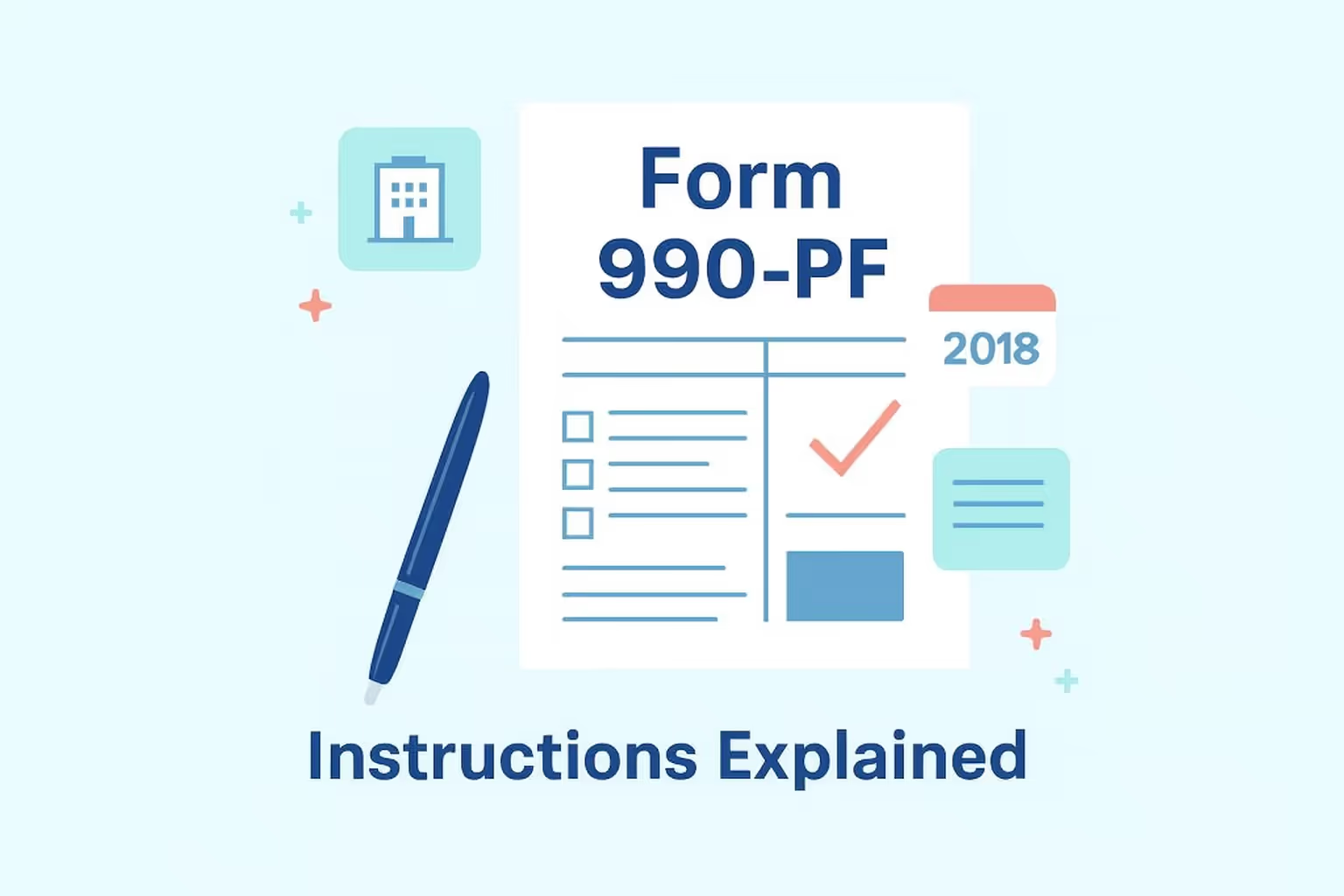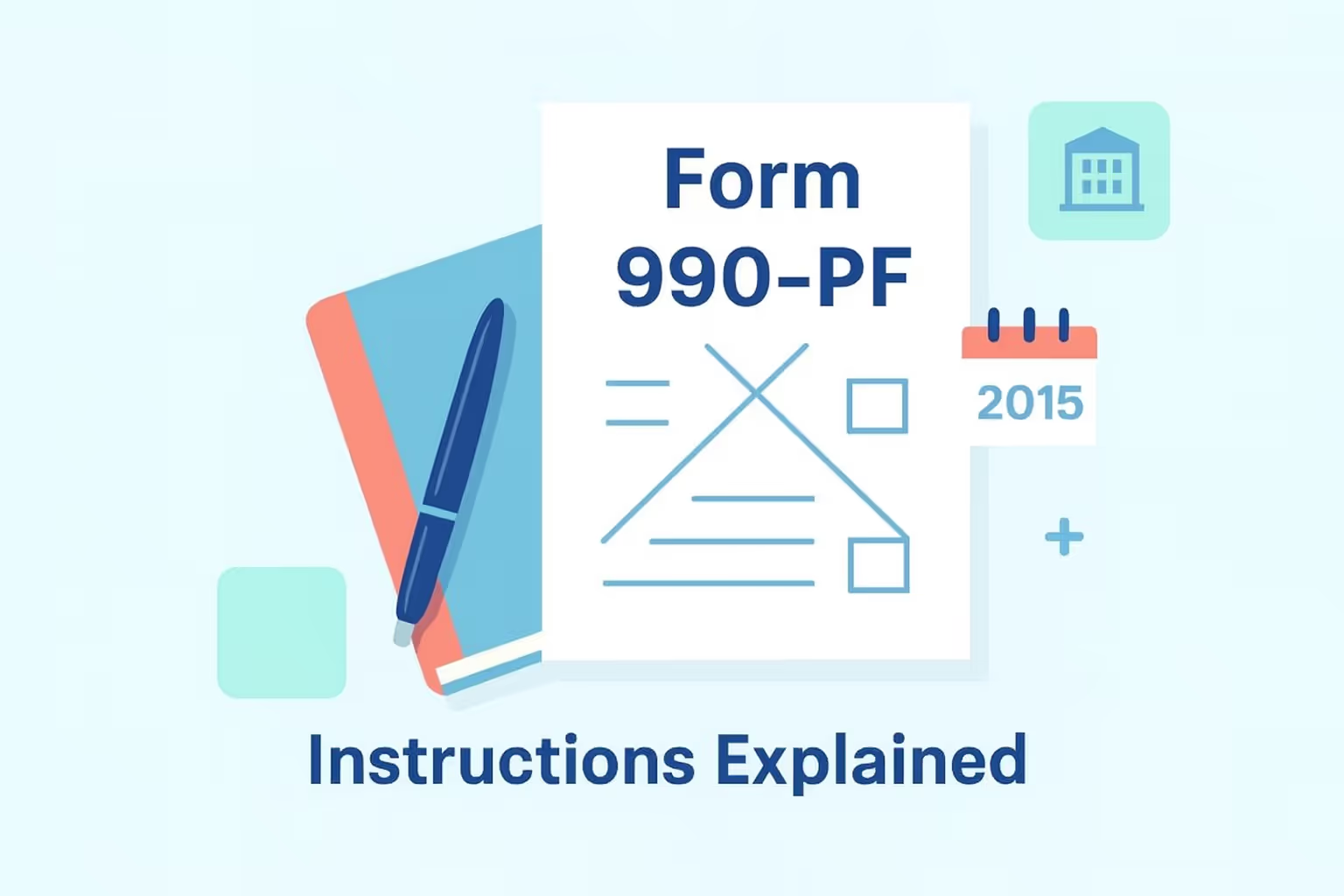Filing requirements can feel overwhelming for private foundations, especially when dealing with federal reporting forms. Form 990-PF is the information return that tax-exempt organizations and nonexempt charitable trusts treated as private foundations must complete each tax year. It provides the Internal Revenue Service with details about income tax obligations, philanthropic distributions, and activities carried out to maintain compliance. For 2021, electronic filing requirements apply to exempt and taxable private foundations, making accurate preparation especially important.
The Form 990-PF 2021 instructions cover a wide range of reporting details, including capital gain and net income, as well as gross receipts. Additionally, the instructions outline how a foundation accounts for program-related investments and expenses incurred during the fiscal year. By following these guidelines, federally tax-exempt organizations can lower the risk of filing errors and maintain compliance with tax laws. The instructions also explain when a foundation must pay income taxes on net investment income, how to calculate adjusted net income, and how charitable distributions affect the organization’s tax-exempt status.
This guide is designed to simplify the rules and present them in plain terms. Our goal is to support private foundation managers, nonprofit organizations, and related entities in meeting their annual filing obligations without unnecessary stress.
Private Foundations and Exempt Status Explained
Private foundations are specialized nonprofit organizations subject to different standards than public charities. Typically established through significant funding from a single donor or entity, they operate with narrower financial sources yet carry extensive reporting obligations under the Internal Revenue Code. Both exempt private foundations and taxable private foundations are required to file Form 990-PF annually, disclosing their gross receipts, net investment income, and charitable distributions. These filings enable the Internal Revenue Service to assess compliance with federal tax laws and verify that funds are allocated to recognized philanthropic purposes.
Private foundation status entails stricter oversight compared to that of public charities. While supporting organizations rely on community contributions, private foundations must demonstrate continued compliance with tax laws governing capital gain, net income, expenses incurred, and excess business holdings.
Nonexempt charitable trusts treated as private foundations are held to these standards as well, particularly when reporting unrelated business income or program service revenue. Each type of entity faces specific responsibilities designed to safeguard its organization’s tax-exempt status.
Key Types of Foundations
- Exempt Private Foundations: These are entities federally recognized as tax-exempt organizations that still report charitable distributions and net investment income.
- Taxable Private Foundations: These entities are required to pay federal income tax if they fail to meet compliance standards.
- Private Operating Foundations: These foundations allocate the majority of their adjusted net income or gross investment income to direct charitable activities.
- Nonexempt Charitable Trusts: These are classified as private foundations under the Internal Revenue Code and are subject to the same filing and compliance requirements.
A thorough understanding of these classifications is essential for proper reporting on Form 990-PF. By maintaining compliance with requirements such as accurate reporting of fund balances and income tax return filings, private foundations strengthen their charitable role while protecting their long-term tax-exempt recognition.
Filing Requirements, Deadlines, and Fiscal Year Rules
Private foundations must meet specific filing requirements that ensure transparency in their handling of charitable activities and financial resources. Each year, exempt private foundations, taxable private foundations, and nonexempt charitable trusts treated as private foundations are required to file Form 990-PF.
This annual filing obligation applies to all entities, even those with no income or activity during the tax year, allowing the IRS to monitor compliance with federal income tax regulations. Late filing can trigger IRS assessments linked to unpaid taxes and threaten the organization’s tax-exempt status.
Filing Deadlines
The deadline for Form 990-PF depends on the foundation’s fiscal year. Private foundations must file on the 15th day of the fifth month following the end of their accounting period. For organizations operating on a calendar year, this deadline typically falls on May 15. Foundations may request a six-month extension using Form 8868 to complete the return. While an extension delays the reporting date, it does not extend the deadline to pay excise tax on net investment income or other required taxes.
Electronic Filing Rules
Electronic submission has become mandatory for nearly all private foundations. Organizations must file electronically through approved providers or authorized software—the IRS e-file system for charities and nonprofits guides users in completing the process. Filing electronically reduces errors, speeds up processing, and confirms receipt of the return.
For federally tax-exempt organizations, e-filing is the only accepted method of compliance. Both domestic private foundations and nonexempt charitable trusts treated as foundations must use this process, regardless of their size in terms of gross receipts.
Fiscal Year Reporting Standards
Foundations must align their filings with either a fiscal year or a calendar year, depending on the accounting method they have adopted. All gross receipts, charitable distributions, adjusted net income, and capital gain net income must be reported for the period selected.
Consistency in fiscal year reporting ensures accuracy across income tax returns, program service revenue, and fund balances. Proper reporting strengthens compliance with tax laws and maintains the foundation’s recognition as a tax-exempt entity.
Meeting these requirements demonstrates accountability and commitment to charitable purposes. Filing accurately and on time safeguards an organization’s tax position, protects its financial integrity, and upholds its role within the broader framework of nonprofit organizations.
Form 990-PF 2021 Instructions: Key Parts of the Return
Form 990-PF contains several sections that outline the reporting duties of private foundations. Each part serves a unique role, from confirming an organization’s tax-exempt status to calculating excise tax based on net investment income. A clear understanding of these parts helps foundation managers and trustees prepare accurate filings and maintain compliance with Internal Revenue Code standards.
- Purpose of the Form
Form 990-PF provides the Internal Revenue Service with financial and operational details about private foundations. Both exempt private foundations and taxable private foundations are required to complete it annually, regardless of their level of activity. The return establishes accountability by requiring disclosures about income, expenses, charitable distributions, and management oversight. - Heading Section
The heading section identifies the filer through its name, address, and employer identification number. It also specifies the accounting method, fiscal year, and status as a private foundation. Nonexempt charitable trusts treated as private foundations must also complete this section, confirming their classification under the Internal Revenue Code. - Revenue and Expense Reporting
Parts I and II focus on the foundation’s financial results. Organizations must report gross receipts, program service revenue, and net investment income. Capital gain, net income, adjusted net income, and gross investment income must also be included for excise tax-based calculations. In addition, expenses incurred, fund balances, and direct charitable activities must be disclosed, giving the IRS a clear view of the foundation’s financial health. - Capital Gains and Leadership Information
Part IV requires a detailed account of capital gains and losses during the tax year. Part VII documents the roles of officers, trustees, directors, and foundation managers. It also requires information about disqualified persons, compensation, and relationships to prevent conflicts of interest. Additionally, specific personal benefit contracts and prohibited tax shelter transactions must be reported to ensure compliance. - Qualifying Distributions and Tax Computation
Several sections address charitable distributions and excise tax obligations. Foundations must carefully track qualifying distributions, program-related investments, and excess business holdings. To ensure compliance, Part V calculates the excise tax on net income, while other schedules reconcile undistributed income with that of prior years. Together, these disclosures ensure compliance with federal tax laws and safeguard the organization’s tax-exempt entity status.
Private foundations that rely on the IRS Instructions for Form 990-PF when preparing their return improve accuracy and reduce filing errors. By accurately documenting income tax obligations, fund balances, and charitable distributions, organizations maintain compliance and continue to serve their charitable mission effectively.
Net Assets, Investment Income, and Capital Gains
Reporting net assets and investment income is one of the most critical elements of Form 990-PF. Private foundations must provide a transparent account of their financial position, including how fund balances, capital gains, and program-related investments affect their overall standing. These disclosures enable the IRS to verify compliance with tax laws and confirm the organization’s tax-exempt status.
Reporting Net Assets
Net assets are divided into two categories: those with donor restrictions and those without. Foundations must present both amounts accurately, reflecting how contributions and program service revenue are allocated. Fund balances should reconcile across accounting periods to ensure consistency in the financial record. Errors in reporting adjusted net income or gross investment income can lead to problems with excise tax obligations and overall compliance.
Documenting Investment Income and Capital Gains
Investment income encompasses revenue from interest, dividends, and rental properties, as well as gains from securities or other assets. Net investment income forms the basis for calculating excise tax on private foundations. Capital gain net income must also be documented in detail to prevent underreporting and to clarify how investment activity contributes to overall financial results. By carefully tracking these amounts, foundations demonstrate compliance with Internal Revenue Code requirements.
Key Reporting Areas for Foundations
- Net Assets: Foundations must distinguish between assets with donor restrictions and those without to ensure clarity in reporting and accounting.
- Gross Investment Income: Foundations must include dividends, interest, and other investment-related revenue in their reports.
- Capital Gains: Foundations must record realized gains and losses from the sale of securities or property.
- Adjusted Net Income: Foundations must calculate this figure to determine excise tax-based obligations and undistributed income.
- Program-Related Investments: Foundations must list investments made to support charitable purposes directly.
- Direct Charitable Activities: Foundations must demonstrate how expenditures from gross receipts are utilized to further the organization’s mission.
Maintaining accurate records of net assets, investment income, and capital gains supports both compliance and transparency. Foundations that track these categories thoroughly strengthen their standing with federal tax authorities, preserve their tax-exempt status, and demonstrate a commitment to using resources effectively for charitable purposes.
Excise Tax Based on Net Investment Income
Private foundations must account for excise tax obligations when filing Form 990-PF. This tax is imposed on net investment income and applies broadly to domestic private foundations and non-exempt charitable trusts that are treated as foundations.
The Internal Revenue Code establishes rules for calculating taxes, requiring foundations to contribute a portion of their investment income to federal revenue. Understanding these requirements is essential for accurate reporting and maintaining continued recognition as a tax-exempt entity.
Core Elements of Excise Tax
- Tax Rate: The excise tax is assessed at 1.39 percent of net investment income. This rate replaced the two-tier structure and now applies uniformly across most private foundations.
- Net Investment Income: Net investment income comprises dividends, interest, rents, and royalties, minus allowable deductions. Capital gain net income is also included in the total.
- Adjusted Net Income: Foundations must calculate adjusted net income for excise tax purposes, ensuring that undistributed income and fund balances align with reporting requirements.
- Who Pays the Tax: All exempt private foundations and taxable private foundations are required to calculate and pay excise tax. Nonexempt charitable trusts treated as private foundations must also comply.
- Payment Process: Organizations pay income taxes using approved federal systems, including electronic transfers and the Electronic Federal Tax Payment System. Timely payment prevents interest from accruing on unpaid tax.
- Filing Integration: The excise tax calculation appears in Part V of Form 990-PF. Foundations must ensure that income tax return figures and excise tax obligations are consistent across the entire filing.
Compliance Considerations
Foundations that fail to report or pay excise tax accurately risk IRS assessments that could jeopardize their tax-exempt status. Careful attention to gross investment income, capital gains, and related deductions strengthens the accuracy of filings. Proper documentation of program-related investments and direct charitable activities helps distinguish taxable amounts from exempt uses of income.
Excise tax reporting highlights the importance of transparency in financial stewardship. By carefully managing net income calculations, private foundations can reinforce their credibility while meeting federal requirements. Accurate compliance not only fulfills obligations under tax laws but also demonstrates the organization’s commitment to responsible use of investment resources.
Private Operating Foundations and Accounting Method
Private operating foundations are a specialized category of private foundations that meet additional requirements under the Internal Revenue Code. Unlike other foundations that primarily make grants, these organizations conduct direct charitable activities.
They must dedicate a substantial share of adjusted net income or gross investment income to philanthropic purposes. Accurate reporting of both operational activities and financial details is crucial, especially since they remain subject to federal income tax rules if compliance is not maintained.
Characteristics of Private Operating Foundations
- Direct Charitable Activities: Private operating foundations must allocate the majority of their income to services or programs that directly further their charitable purpose, such as educational, scientific, or religious endeavors.
- Distribution Requirement: Private operating foundations must allocate at least 85 percent of the smaller of adjusted net income or minimum investment return to active charitable functions.
- Program-Related Investments: These investments can include loans or equity interests if the primary purpose is to support charitable objectives, rather than generating a return on investment.
- Reporting on Form 990-PF: Foundations must document expenses incurred and program service revenue to show compliance with required distribution levels.
- Status Benefits: Private operating foundations are often treated more favorably when receiving contributions from donors, since they operate similarly to public charities.
Accounting Method Options
- Cash Accounting: This method reports income when it is received and expenses when they are paid. It is suitable for smaller domestic private foundations with straightforward financial activity.
- Accrual Accounting: This method records income when it is earned and expenses when they are incurred, rather than when cash is received or paid. It is required for larger organizations with significant fund balances or complex operations.
- Consistency Requirement: Foundations must use the same accounting method consistently across all filings, unless the IRS approves a change in process.
- Impact on Net Income Reporting: The chosen method directly affects how gross receipts, capital gains, and expenses are calculated for excise tax-based obligations.
- Transparency in Records: Accurate and consistent accounting ensures clarity in income tax return filings, supporting compliance with federal tax laws.
Importance of Accurate Reporting
- Maintaining Tax-Exempt Status: Proper allocation of resources to charitable activities helps preserve recognition as a tax-exempt entity.
- IRS Oversight: IRS oversight ensures that the Internal Revenue Service can verify compliance with rules for exempt private foundations.
- Foundation Managers’ Role: Managers must review accounting practices and confirm that returns reflect accurate data.
- Financial Integrity: Financial integrity demonstrates to donors and regulators that the foundation is responsible in its application of resources.
Effective compliance with private operating foundation rules and consistent accounting practices support credibility and long-term sustainability. By following these standards, foundations can protect their tax-exempt recognition while advancing meaningful charitable missions.
Foundation Managers, Undistributed Income, and Tax-Based Rules
Private foundations must demonstrate careful management of both financial reporting and compliance with federal tax obligations. Foundation managers, trustees, and officers are responsible for ensuring that annual filings comply with Internal Revenue Code requirements. A significant part of this responsibility involves tracking undistributed income, reporting excise tax-based amounts, and avoiding unpaid tax that could jeopardize the organization’s exempt status.
Step 1: Identify Foundation Managers
Each private foundation is required to disclose the names, roles, and compensation of its officers, directors, and trustees on Form 990-PF. Managers are accountable for overseeing charitable distributions, program service revenue, and compliance with federal income tax requirements. Proper identification establishes accountability and prevents conflicts of interest involving disqualified persons or personal benefit contracts.
Step 2: Calculate Net Investment Income
Managers must ensure the foundation calculates net investment income, which includes dividends, interest, and capital gains. This figure determines the excise tax obligations reported in Part V of the return. Accurate calculations prevent underreporting and demonstrate that the foundation applies tax laws correctly across its fiscal year.
Step 3: Monitor Undistributed Income
Foundations must distribute a minimum percentage of their assets annually to maintain exempt private foundation status. Any undistributed income must be reported and reconciled across tax years. If distributions fall short, the foundation risks additional tax assessments and potential questions regarding its organization’s tax-exempt status.
Step 4: Track Excise Tax and Unpaid Amounts
Excise tax must be paid on time through approved systems. If tax remains unpaid, the IRS may impose charges and require payment of additional amounts. Managers must verify that income tax return filings, tax paid, and excise obligations align across the foundation’s records.
Step 5: Address Special Situations
Certain situations require additional attention. Foundations with gross receipts exceeding thresholds must provide expanded reporting, while those with unrelated business taxable income may need to file separate returns, such as Form 990-T. Managers must also ensure compliance with rules covering excess business holdings and prohibited tax shelter transactions.
Step 6: Sign and File the Return
Only authorized officers or trustees may sign Form 990-PF. Electronic filing is mandatory for most tax-exempt organizations, and returns must be submitted within the required deadline for the fiscal year. The signature confirms that the manager has reviewed the form and ensured accuracy.
Foundation managers play a central role in safeguarding compliance. Tracking undistributed income, excise tax-based obligations, and management disclosures help preserve the organization’s exempt recognition. Strong oversight reinforces credibility with regulators and ensures that charitable resources continue supporting the foundation’s mission effectively.
Common Filing Errors and IRS Guidance
Errors in completing Form 990-PF can weaken a foundation’s compliance efforts and result in additional IRS tax assessments. Many mistakes involve incomplete schedules, missing disclosures, or inaccurate figures that affect how the Internal Revenue Service evaluates the return. Understanding the most frequent errors helps foundation managers avoid them and protect the organization’s tax-exempt status.
Action Steps to Prevent Filing Errors
- Complete Schedule B
Foundations must include Schedule B or certify exemption from it. Missing this attachment or failing to check the appropriate box remains one of the most common errors identified during IRS review. - Verify Balance Sheets
Incomplete or inaccurate balance sheets create problems with reconciling fund balances. Foundations with assets of $5,000 or more must complete all columns, including fair market value, to show a complete financial picture. - Report Charitable Distributions
Omitting the purpose of grants or failing to document charitable distributions weakens compliance. Foundations must explain how contributions or program-related investments serve philanthropic purposes. - Check Part XV and Part X
Leaving these sections incomplete when required leads to IRS correspondence. Part XV must show grant purposes, and Part X must reconcile distributable amounts for most domestic private foundations. - Confirm Signatures and Authority
Unsigned returns or signatures from unauthorized individuals, such as staff without trustee status, are invalid. Only authorized officers or trustees can sign the income tax return on behalf of the foundation. - Avoid Incorrect EIN or Dates
An inaccurate employer identification number or mismatched fiscal year dates often result in processing delays. Managers must confirm that all identifying information matches IRS records. - Review Excise Tax Calculations
Excise tax based on net investment income must be calculated correctly. Errors in this area often stem from misreporting adjusted net income, gross investment income, or capital gain net income. - Protect Sensitive Information
Returns must not include Social Security numbers, bank account information, or other personal data. Private foundations are subject to public disclosure rules, and protecting privacy is a compliance requirement.
Avoiding these errors requires a strong internal review before filing. When foundations follow IRS guidance and verify each step, they reduce compliance risks, improve accuracy, and maintain confidence in their exempt status. Careful preparation ensures the return reflects integrity and supports the foundation’s mission.
Frequently Asked Questions
When is Form 990-PF due for the 2021 tax year?
Form 990-PF for tax year 2021 must be filed on the 15th day of the fifth month after the close of the fiscal year. For calendar-year private foundations, the deadline is May 15. Extensions may be requested through Form 8868, though excise tax based on net investment income and any estimated tax obligations must still be paid. Meeting deadlines helps preserve an organization’s tax-exempt status under the Internal Revenue Code.
Do private foundations with no activity still need to file tax returns?
Yes, even private foundations with no activity are required to file Form 990-PF each year. Organizations must report zeros for gross receipts, disclose fund balances, and confirm charitable distributions, even if none were made. Nonexempt charitable trusts treated as foundations also follow this rule. Filing prevents automatic revocation of the foundation’s tax-exempt status and ensures compliance with federal tax laws governing exempt private foundations and taxable private foundations.
What excise tax rate applies to private foundations?
Private foundations pay a 1.39 percent excise tax on their net investment income, which includes dividends, interest, rents, royalties, and capital gains, minus any applicable deductions. The tax applies to both exempt and taxable private foundations. Managers must submit payment with the return to avoid IRS assessments for unpaid or miscalculated amounts.
Who is authorized to sign Form 990-PF?
Only foundation managers with recognized authority may sign Form 990-PF. Acceptable signatories include the president, vice president, treasurer, assistant treasurer, or an authorized trustee. A signature confirms accuracy in reporting gross receipts, charitable distributions, and adjusted net income. Incomplete filings without an authorized signature can invalidate the return, raising compliance risks for both domestic private foundations and nonexempt charitable trusts treated as private foundations.
How is undistributed income reported?
Undistributed income must be tracked and reported across fiscal years to confirm compliance with payout requirements under the Internal Revenue Code. Private foundations are required to distribute a specified percentage of their assets annually through charitable distributions or program-related investments. If undistributed income carries over, it must be reconciled on Form 990-PF. Failure to report properly can affect a foundation’s tax-exempt status and increase excise tax-based obligations.
Do private operating foundations follow different rules?
Yes, private operating foundations must dedicate at least 85 percent of adjusted net income or minimum investment return to direct charitable activities. These organizations file Form 990-PF like other private foundations, but must report program service revenue, fund balances, and expenses incurred to prove compliance. Their structure offers benefits when receiving contributions, but it also requires stricter adherence to tax laws, including the reporting of net investment income and capital gains.
What happens if the tax remains unpaid?
If excise tax, estimated tax, or income tax-based amounts remain unpaid, the Internal Revenue Service may apply charges and interest. Foundation managers are responsible for ensuring that payments accurately reflect gross investment income, capital gain net income, and adjusted net income. Unpaid tax can put an organization’s tax-exempt entity status at risk. Accurate filing and timely payment safeguard compliance while supporting the foundation’s mission of charitable distributions.





























